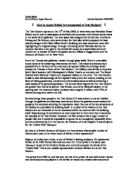The Saatchi Gallery displays contemporary art, produced by young artists and international artists whose work has not often been exhibited in the U.K. and is a private collection belonging to Charles Saatchi. To a certain extent, the work is generally unsettling and thought provoking. It is positioned at eye level, which allows it to be viewed with minimal effort, and although the work is not protected by barriers, there is a feeling that touching is not allowed. It is not always easy to determine which piece of text belongs to which exhibit, as the plaques are positioned some distance from the artwork, making it rather confusing.
The work did not appear to be set out thematically, or chronologically, however it was displayed aesthetically, with the large three-dimensional pieces together in one room, and the smaller works in the corridors between rooms. The life-like figures of Duane Hanson are a prominent feature throughout the gallery, the positioning making them even more realistic.
Within the Saatchi Gallery most of the pieces are exhibited in the many corridors and rooms leading from them. There is one large room named the Rotunda room where the shark of Damian Hirst is displayed, as well as work from other Young British Artists (YBA’s). Sculptures work best in this tall round room, rather than paintings and photographs, which are exhibited in the smaller office rooms.
Many artists that exhibit their work at the Saatchi are initially unknown to the public and the critics. This helps some to be recognised and after their work is shown, many are offered spaces at other galleries.
The atmosphere at this gallery felt full of suspense, and anticipation as the work and what it represented was viewed. The pieces were spread out and the small three dimensional items displayed on plinths to catch the eye. Some of the rooms leading from the main corridor had names from its former use, acting as a gentle reminder of its past. One such room was named the ‘Boiler Room’. Inside were quite crude models made from un-fired clay. The walls were white and the floor was grey concrete. There was no colour in the room, and the pipes and beams had all been painted in the same grey. This grey unfinished look seemed to reflect the mood of the models, and the atmosphere it created.
The rooms were all different sizes and some had unused doors. One particular room contained African style masks by Jake and Dinos Chapman. The masks represented commercialism as they were discretely branded with McDonalds signs. Incense that wafted into the room with fans, created the right ambiance, and stimulated the senses to make the McDonalds brand even more discrete.
The Chapman brother’s work of crude models of children with genitals as part of their faces is spread around the gallery in different rooms. Some of them are amongst other artist’s work but the most impacting room was decorated with leaves and trees so it looked like a garden. Amongst the foliage were models in different sexual positions, all wearing wigs and trainers to make them more disturbing. This room could only be entered a few metres which made it more effective as everybody viewed the piece from the same position.
Another impressive room was Richard Wilson’s 20:50. This room allowed one person at a time to enter, as the room was waist high in oil supported by vertical sheets of metal. One knock of the metal and the oil would spill over the side. The piece played games with the observer’s eyes because the oil reflected so well, causing the viewer to perceive the oil as just a thin film of oil.
It is very interesting to observe the visitors to the gallery. The area is filled with an un-requested silence, leaving the air filled with a gentle whispering sound. This gallery does not appear to attract many children, possibly due to the nature of the work, or the cost of entry. It therefore attracts mainly enthusiasts and art students. Galleries such as the Tate, which have free entry, attract more people that go for the experience or out of general interest, where as the private collections attract people specifically interested in that particular type of art. The interest in contemporary art has increased, attracting a wider range of people. Where as initially only people who were dedicated to contemporary art visited to see the work of the YBA, many colleges, universities, and more of the general public now visit.
Part of me feels that the crude sexual pieces displayed inside insult the historic grand classic building that encompasses them, and another part of me can see that County Hall is the perfect place for the Gallery.
Personally I do not think that Art Galleries will ever be out of date, compared with new technologies, because of the pure intensity of visiting amazing pieces of work. Television can never compare with seeing the pieces for yourself and the experience of visiting the gallery as a whole. The public pays an entry fee for the privilege of viewing Charles Saatchi’s private collection, which helps towards the upkeep of the building and the wages of the staff that run the gallery for him.







